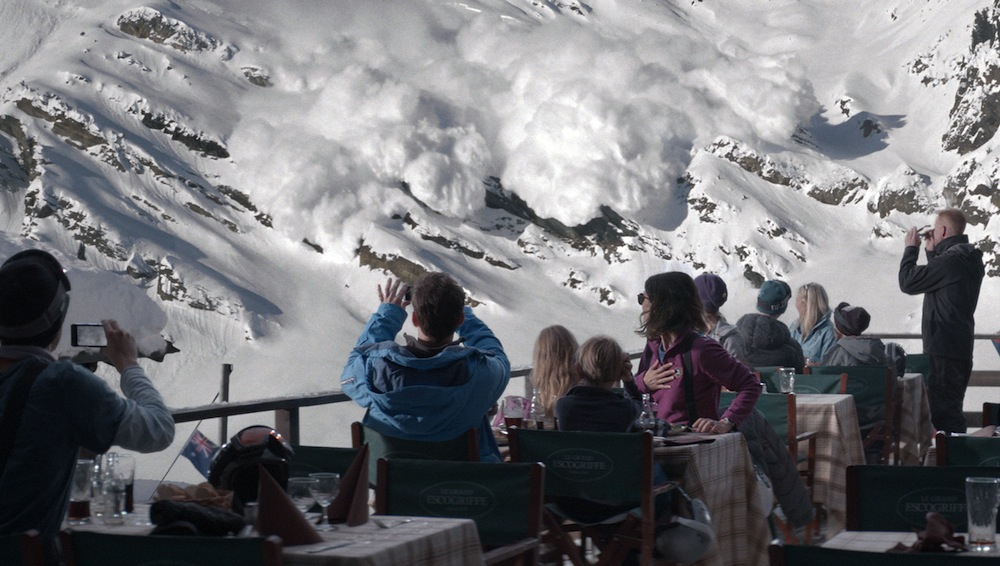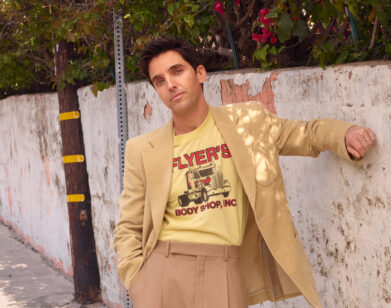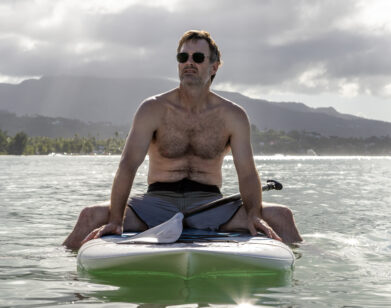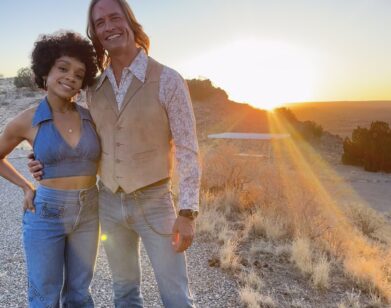Ruben Ã?stlundâ??s Force of Nature

ABOVE: JOHANNES BAN KUHNKE, VINCENT WETTERGREN, CLARA WETTERGREN, AND LISA LOVEN KONGSLI IN FORCE MAJEURE, A MAGNOLIA PICTURES RELEASE. PHOTO COURTESY OF MAGNOLIA PICTURES.
Swedish director Ruben Östlund has long been preoccupied with the dynamics of human behavior, such as the psychology of gang tactics (2011’s Play) and the physical and mental confusion that accompanies witnessing a bank robbery (2009’s Incident by a Bank). But with his latest film, the biting black comedy Force Majeure, his interest in group dynamics refocuses to the below-the-surface traumas of the domestic space.
Östlund, who got his start making ski films in his early 20s, returns to a familiar landscape: a serene, idyllic ski resort in the French Alps. Centering on a prototypical nuclear family on holiday: handsome businessman father Tomas (Johannes Kuhnke), model-esque mother Ebba (Lisa Loven Kongsli), and two flaxen-haired children, the critical juncture that punctures the façade of their picture-perfect lives occurs when an avalanche appears to advance on the outdoor restaurant where they’re eating lunch. In the end, they’re all merely coated with a dusting of powder, but in the panic, Tomas instinctively grabs his phone and runs for cover, leaving Ebba and the children to fend for themselves.
What follows is a tense narrative that unspools over the course of several days, revealing Tomas’ complicated relationship with his expected role as patriarch, and Ebba’s mounting disillusionment. Östlund’s approach to skewering performative behavior and gender constructions is astute and razor-sharp; he’s interested not just in the breakdowns of prescribed societal roles, but in their perpetuation through culture and the media.
Interview recently spoke with Östlund when he was in New York.
COLLEEN KELSEY: Why did you decide to center your film on the primal, survival aspect of human behavior?
RUBEN ÖSTLUND: I’ve been interested in human behavior for a long time. It’s a thematic aspect of the content of my films; I’ve been focusing on group behavior. When I was around 20 and 25, I was skiing in the Alps, and a little bit in North America. I have been looking for a way to get back into that environment; to do something in a ski resort. But that world is so kitschy—neon colors, mirror goggle lenses, and well-to-do people that are in control of their lives. There’s not many existential things taking place there. But then I saw a YouTube clip of a group of tourists sitting at an outdoor restaurant watching an avalanche tumbling down a mountain, and I got interested in the three seconds where the cheering goes from “Wow!” to total panic. I thought it was so humorous when those two moments are so close to each other; when we have the danger in control, and when we suddenly are fearful of losing our life. You know when you go to the zoo, and you watch animals—there’s someone watching them and then falling into the lion pit.
KELSEY: Well, it’s interesting because something that I first noticed during the avalanche scene is how many people are taking out their phones to film it. Their interaction with what is happening is through a media device. And then when it switches to “This is actually a threat,” that’s the shift.
ÖSTLUND: That was the basic idea, but it didn’t solve my problem to let the film take place in a ski resort. I told my friend that my idea was to have a Swedish family on this ski vacation and at this outdoor restaurant, and then he said, “What about if the father runs away, and he leaves his wife and his kids?” In that moment we have something very interesting. It’s raising questions about gender, and expectations on gender, and the role of the man and the role of the woman, and the nuclear family.
KELSEY: This entire family, their lives are very controlled in terms of being Western, bourgeois; they’ve decided to take a vacation, they’ve decided to have their careers and what have you, but when there’s a moment where something is out of their control, it creates a rupture.
ÖSTLUND: I was inspired by an investigation around airplane hijackings. The frequency of divorce is extremely high after hijackings. Even though you survive, you have seen your partner. “I don’t want to continue living with this person.” All the expectations that we have on gender and—if you look at cinema history—I think the most reproduced character is the woman as a sex object, and second, the man as a hero. When you look at statistics, you can tell that men are actually the ones that survive when it comes to catastrophes. Even though that we have the myth of the Titanic, and we save women and kids first in the lifeboats, this is not true. It’s very often that the captain is the one who first leaves the ship. But we think the captain will sink.
KELSEY: That obligation has been a societal construct. In the development of Ebba and Tomas, they are very much performing their role in the structure of the family, the patriarch, the matriarch. To what extent do you think that those roles are a façade? Maybe less for Ebba, and more for Tomas?
ÖSTLUND: Maybe. Maybe not. I was also interested in looking at the nuclear family from a historic perspective because the word “nuclear family” was invented in the ’40s. Suddenly we say, “The most important thing for kids are the mother and the father.” I think that a lot of things that we think are connected to genuine emotions are emotions that are created around a construction. I don’t think that the role of the woman is more or less free than the man is. I think we have different demands on the sex. For example, when you hear about the father who is raising the kids you immediately think, “Where is the mother?” But when the mother is raising the kids you don’t immediately think, “Where is the father?”
KELSEY: Well, today the nuclear family is seen as a sort of ideal because a lot of families are divorced or remarried.
ÖSTLUND: Yeah, but I think we are also developing a lifestyle that is very connected to the capitalistic consumer society. So, in Stockholm for example, it’s the city in the world with the most single households, and if we are living alone, in every apartment, we are getting more and more efficient as consumers. Instead of being four people and buying one TV, we will be one person buying one TV. In a way it’s a liberation. The more resources we have, the more free we are able to be. It’s interesting that being free is similar to being alone, almost. [laughs]
KELSEY: I also wanted to talk about the two characters—Mats, the divorced guy, and the woman in an open marriage. They’re leading these parallel lives and throw the behavior of Ebba and Tomas into relief. What was your strategy there?
ÖSTLUND: I wanted them to reflect on the idea of the nuclear family, of course. Mats, he’s divorced and has a young girlfriend, but Vera, she has all those promiscuous ideas, and I wanted her to talk about her life in a provocative way. In the end, when she’s the only one that is on the bus, I almost wanted the audience to hope for her to crash down.
KELSEY: Really? [laughs]
ÖSTLUND: So she could be punished for this sinful lifestyle that she has.
KELSEY: I saw her as the person with all the answers.
ÖSTLUND: Yeah. [laughs] Me too, in a way. But if you look at conventional movies, she would have been punished. For an example, Fatal Attraction, with Glenn Close and Michael Douglas—that is the typical person that is disturbing the peace of the nuclear family and should get punished.
KELSEY: I know the avalanche idea came from a YouTube clip; but I read that YouTube on a larger level affected the making of this film.
ÖSTLUND: The “Worst man cry” is something that I YouTube’d. And the bus scene, with the driver, that was part of a clip called “Idiot spanish bus driver almost kills students.” [laughs]. And the avalanche is, as I told you, a YouTube clip. I think that the strongest experiences I have of moving images are not from the cinema; it’s from the Internet and from YouTube. I think that’s what we have to compare ourselves with. If we are working as a director, those must be the images that we are comparing our work with because otherwise I think that cinema will be treated the same way as we are treating opera today—just culture that we have because of its historical value. We need to update that tradition.
KELSEY: The “worst man cry” scene, where Tomas is having that breakdown, and he’s admitting to his failure to measure up to the husband-father ideal, do you think that he is sublimating his identity? Because in the ending he’s more open about who he is when he smokes in front of his child.
ÖSTLUND: For me, the “worst man cry” is something that is, first of all, he’s having this fake cry. And the fake man cry could be compared to the fake woman orgasm. [laughs] It’s something that all men have done, everybody has faked their cry sometimes if you are a man. But, I was thinking of Tomas as someone that is pushing down his emotions so much, so finally it just bursts out, and he doesn’t have any control over it at all.
KELSEY: Do you think that cinema is just reinforcing the tropes that it’s created throughout history, and not breaking new ground?
ÖSTLUND: It’s an economical industry, rather than saying something about society. But it’s also building ideology. Why are we reproducing the male hero character so much? That’s because we want men to be loyal towards the country, towards the football team, towards bigger questions. And I think it would be impossible to make man go to war if we didn’t have this reproduction of the male hero. The culture that we have is creating the society, and of course the culture that we have today is creating a new kind of society. We have to look at the power and the potential of moving images in a new way.
FORCE MAJEURE IS OUT IN LIMITED RELEASE TODAY






